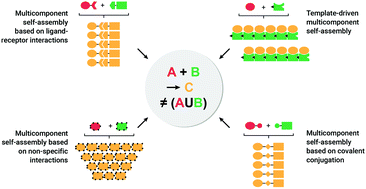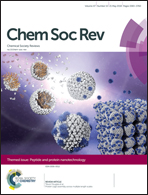Multicomponent self-assembly as a tool to harness new properties from peptides and proteins in material design
Abstract
Nature is enriched with a wide variety of complex, synergistic, and highly functional protein-based multicomponent assemblies. As such, nature has served as a source of inspiration for using multicomponent self-assembly as a platform to create highly ordered, complex, and dynamic protein and peptide-based nanostructures. Such an assembly system relies on the initial interaction of distinct individual building blocks leading to the formation of a complex that subsequently assembles into supramolecular architectures. This approach not only serves as a powerful platform for gaining insight into how proteins co-assemble in nature but also offers huge opportunities to harness new properties not inherent in the individual building blocks. In the past decades, various multicomponent self-assembly strategies have been used to extract synergistic properties from proteins and peptides. This review highlights the updates in the field of multicomponent self-assembly of proteins and peptides and summarizes various strategies, including covalent conjugation, ligand–receptor interactions, templated/directed assembly and non-specific co-assembly, for driving the self-assembly of multiple proteins and peptide-based building blocks into functional materials. In particular, we focus on peptide- or protein-containing multicomponent systems that, upon self-assembly, enable the emergence of new properties or phenomena. The ultimate goal of this review is to highlight the importance of multicomponent self-assembly in protein and peptide engineering, and to advocate its growth in the fields of materials science and nanotechnology.

- This article is part of the themed collection: Peptide and protein nanotechnology


 Please wait while we load your content...
Please wait while we load your content...